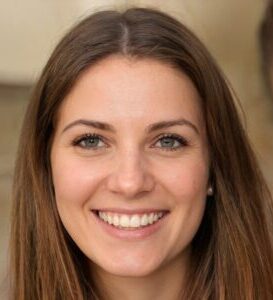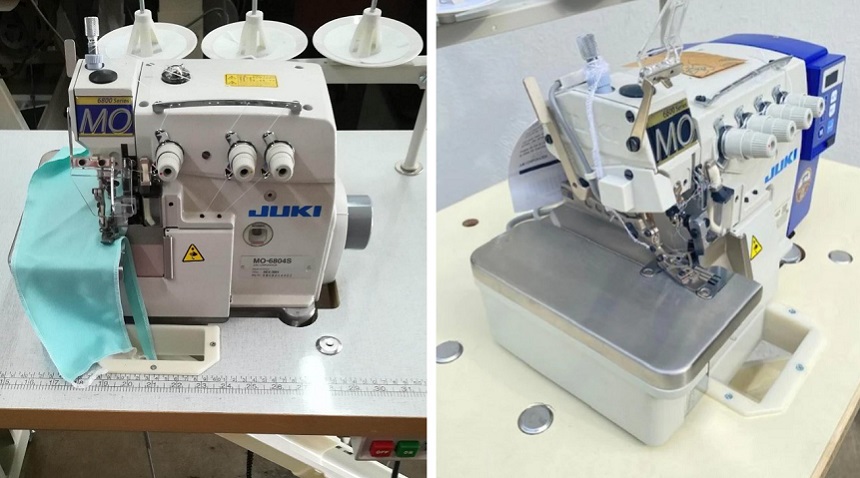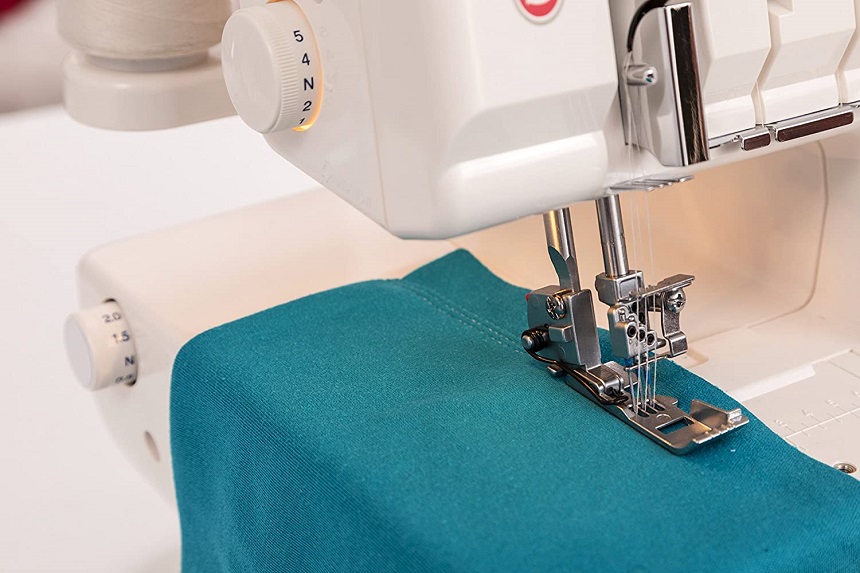

Did you know that an overlock machine can be used for more than just finishing the edges of fabric? These versatile machines can be used for a variety of sewing projects, from creating ruffles and gathered fabrics to sewing elastics and trims.
To help you make an informed decision, we’ve put together a list of the six best overlock machines on the market, complete with a buyer’s guide. These overlockers offer a variety of features that make them perfect for both beginner and experienced sewers. They produce high-quality stitches on different fabrics and come with a variety of speed settings, so you can sew at your own pace. They are also easy to set up and use, so you can get started on your projects right away.
(Need to stock up on thread? Take a look at our 5 best serger threads in THIS article!)
Other features: differential feed, push-button stitch adjustment, automatic lubrication, electronic DC servo motor
The Juki MO-6814S is a great choice for those who are looking for an industrial overlock machine. It is built to last and can sew through heavy-weight materials with ease. It has a differential feed that prevents fabric from bunching up, and it also has a push-button stitch adjustment that allows you to easily change the stitch length. We were impressed that the Juki MO-6814S also comes with an automatic lubrication system that keeps the machine running smoothly, and it also comes with a sewing machine table and Electronic DC Servo Motor.
The Juki MO-6814S is part of the 6800 series, but it differs from the base 6804 in a number of ways. While the stitch speed and length is the same on both models, the 6814S has 2 needle overlock compared to the 1 on the 6804 and 514 Stitch styles compared to 504. Another key difference is the 6804 only has two overedging widths, while the 6814 has three.
Other features: self-adjusting tension system, Rolled Hem sewing mode, 14 stitch options, adjustable cutting width, stitch length control
The Singer Pro 5 14T968DC is one of the best overlock machines on the market, and for good reason. It has a self-adjusting tension system that ensures perfect stitches every time, as well as color-coded threading to make set-up a breeze. Additionally, its rolled hem sewing mode is perfect for delicate fabrics, and it has a whopping 14 stitch options to choose from. Plus, it’s easy to use with an accessible lever to adjust the cutting width and a stitch length control. Best of all, it comes with a 2/25 year warranty, so you can be sure it will stand the test of time.
Singer has a number of heavy duty overlock machines, but the Singer 14T968DC differs from many of the other models in the line. While the HD0400S has a similar speed, it only has 2/3/4 threads while the 14T968DC has 2/3/4/5. Additionally, the HD0400S is supplied with one general foot, but the 14T968DC kit includes seven feet including a general purpose foot, beading foot and elastic foot.
Other features: lay-in threading system, retractable upper knife, Quick change rolled hem, wide open threading, differential feed, pretension setting slider
The Janome MOD-8933 overlock machine is a great value for the price. It has a wide range of features that make it a great choice for anyone looking for an overlock machine. The lay-in threading system is easy to use and the color-coded thread guides make it easy to keep track of your threading. The retractable upper knife is a great feature that allows you to quickly change the rolled hem. The wide open threading is also a great feature that makes it easy to adjust the presser foot pressure. The differential feed is another great feature that allows you to easily control the fabric.
The Janome MOD 8933 sits above the 8002DG in the Janome line, but there are some key differences we can point out. On the surface, the models appear similar; both are 3/4 with a speed of 1300. However, the 8933 has a front cover that opens on both the left and right for easier access, a more easily accessible lower looper and a lower looper pretension slider. While these may not seem like major additions, they do relieve some of the frustration when you’re dealing with a complex project.
Other features: metal frame, numbered upper and lower thread loopers, instructional video and printed manual, built-in storage
The Brother DZ1234 Overlock Machine is a great choice for those looking for a machine that can handle piping. This machine has 3/4 threads and an overlock seam width of 3-7 mm. It also boasts a speed of 1,300 spm, making it one of the faster machines on the market. It also has a metal frame and is color-coded for easy threading. Additionally, the Brother DZ1234 Overlock Machine comes with an instructional video and printed manual to help you get started. It also has 2 sets of starter thread and built-in storage for your convenience.
While the Brother DZ1234 and 1034 appear very similar, we found that the DZ1234 has a more comprehensive accessory kit. The machines themselves have very little to separate them, but the DZ1234 includes a Blind Hem stitch foot, starter threads and a gathering foot and piping foot. This makes the Brother DZ1234 best for piping and essential if your future projects will include piping.
Other features: automatic rolled hem, adjustable stitch length, adjustable differential feed, heavy-duty knife system, automatic rolled hemming, multi-purpose foot
The Juki MO644D is a high-quality overlock machine that is perfect for home use. The first thing to note about the MO644D is that it has an automatic rolled hem feature. This is a great feature for those who want to sew light to medium-weight fabrics. The machine also has a color-coded threading guide, which makes it easy to thread the needles. Additionally, the MO644D has an adjustable stitch length and differential feed. These features allow you to customize your stitches to fit your specific needs. Finally, the MO644D has an easy knife adjustment feature. This allows you to quickly and easily adjust the blade depth, making it a great choice for those who want a machine that is easy to use.
The Juki overlock line appears aesthetically similar, but the key difference between the Juki MO644D and the MO645DE is the adjustable presser foot pressure. This allows you to set the amount of pressure the foot places on the fabric via an adjustment dial. This is a fantastic feature if you tend to work with both thicker fabrics and lightweight sheer fabrics. You can easily switch between them to allow the machine to evenly feed the fabric.
When it comes to overlock machines, there are a few things you need to keep in mind before making your purchase. Here is a guide to help you understand what an overlocker is and how to choose the best overlock machine for your needs.
An overlocking sewing machine is a machine that is specially designed to finish the raw edges of the fabric by binding them with thread. Overlockers are also known as a type of serger, but ‘proper’ sergers typically handle more versatile tasks. These machines are different from regular sewing machines because they have multiple needle and thread settings, as well as an adjustable stitch width.
An overlock machine and a coverstitch machine are often confused with one another. While both machines are used to finish the raw edges of fabric, an overlocker does this by binding the fabric with thread. A coverstitch machine, on the other hand, simply sews a decorative stitch on the fabric edge.
 There are three different types of overlock machines: two-thread, three-thread, and four-thread.
There are three different types of overlock machines: two-thread, three-thread, and four-thread.
A two-thread overlock machine is the most basic type of an overlocker. It has two needles and two threads. This type of machine is best for simple Hemming and seaming.
A three-thread overlock machine is a step up from the two-thread machine. It has three needles and three threads. This type of machine can do everything that a two-thread machine can do, plus it can add a decorative stitch to the fabric edge.
A four-thread overlock machine is the most advanced type of overlocker. It has four needles and four threads.
This type of machine can do everything that a three-thread machine can do, plus it can sew a flatlock stitch. This is what a buyer would want in a professional overlock machine.
There are also 5-thread overlocking sewing machines available, but they are not as common. If you are not sure what kind of thread to use on your overlocker, you should also check out our list of the best serger threads.
Now that you know the basics of overlocking sewing machines, it’s time to start shopping for one. Here are a few factors to keep in mind when making your purchase:
 The first thing you need to consider is the type of fabric you will be working with. If you are only going to be working with lightweight fabrics, then a two-thread or three-thread machine should suffice. However, if you are going to be working with heavier fabrics, then you will need a four-thread machine.
The first thing you need to consider is the type of fabric you will be working with. If you are only going to be working with lightweight fabrics, then a two-thread or three-thread machine should suffice. However, if you are going to be working with heavier fabrics, then you will need a four-thread machine.
Also, if you are going to be working with delicate fabrics, look for an overlocker that has a built-in roller guide. This will help prevent the fabric from being pulled into the machine.
Stitch Width
Another important consideration is the stitch width. Most overlock machines have a maximum stitch width of 7mm. If you plan on sewing very thick fabrics, you’ll want to choose a machine with a wider stitch width.
Stitches It Can Do
You need to consider the different types of stitches the overlock machine can do. Most machines can do a basic straight stitch, as well as a decorative stitch. If you plan on doing a lot of decorative stitching, you’ll want to choose a machine that has more stitch options.
Stitching Speed
The stitching speed is also an important consideration. Most machines have a stitching speed of around 1,500 stitches per minute. If you plan on doing a lot of sewing, you’ll want to choose a machine with a higher stitch rate.
Knife Blade
An overlock machine with a knife blade is able to cut the fabric as it sews. This is a handy feature to have if you don’t want to use scissors to cut the fabric after it’s been sewn.
Needles
You’ll want to consider the type of needles the machine uses.
Most overlock machines use standard sewing machine needles. However, some machines require special overlock needles. Be sure to check the needle requirements before making your purchase.
Differential Feed
Differential feed is a feature that allows you to adjust the speed at which the fabric is fed through the machine. This is an important feature to have if you plan on sewing very thick or very thin fabrics.
Ease of Use
When it comes to overlock machines, ease of use is an important consideration. You’ll want to choose a machine that is easy to thread and has clear instructions. If you’re new to sewing, you may want to choose a machine that has an automatic needle threader. Take a look at our reviews of the best sergers for beginners and the list of the best self-threading sergers that will definitely prove useful.
Warranty
Before making your final purchase, be sure to check the warranty. Most overlock machines come with a standard one-year warranty. However, some companies offer extended warranties for an additional fee.
Price
Of course, price is always a consideration when making any purchase. Professional overlock machines can cost well in excess of $1,000. If you’re just starting out, you may want to choose a less expensive machine.
Accessories
Last but not least, you’ll want to consider the accessories that come with the overlock machine. Most machines come with a variety of feet, including a gathering foot and a blind hem foot. Some machines also come with an accessory kit that includes things like scissors and thread holders.
Other Features to Consider
In addition to the features listed above, there are a few other things you may want to keep in mind when choosing an overlock machine.
Weight and Portability: If you plan on taking your machine to classes or traveling with it, you’ll want to choose a light-weight machine that is easy to carry.
Storage: You’ll also want to consider where you’ll be storing your machine. If you have limited space, you may want to choose a machine that comes with its own storage case.
Ease of Maintenance: Finally, you’ll want to consider how easy the machine is to maintain. You’ll want to choose a machine that is easy to clean and oil.
To clean the inside of the machine, start by removing the needle plate and cutting blades. Use a soft brush to remove any lint or debris. You can also use a vacuum cleaner with a soft brush attachment to clean the machine.
To clean the outside of the machine, use a soft cloth to wipe away any dirt or lint. You can also use a mild soap and water solution to clean the machine.
Skipped stitches can be caused by several factors, including incorrect tension, dull needles, or incorrect threading.
Tension problems can be caused by incorrect tension settings, incorrect threading, or use of the wrong type of thread.
Thread breakage can be caused by several factors, including incorrect tension, use of the wrong type of thread, or damage to the threads.
If you are having problems with your overlock machine, we recommend checking the manual for troubleshooting tips. You can also contact the manufacturer for further assistance.
The Brother 1034DX is our top choice for beginner and experienced sewers alike. It comes with seven stitch options, a differential feed, and three accessory feet that make it perfect for a variety of sewing projects.
The Juki MO-6814S is perfect for handling heavy-weight materials and comes with a differential feed, push-button stitch adjustment, and automatic lubrication.
The third place on our list of the best overlock machines takes the Singer Professional 5 Serger. This machine has a variety of stitch options, as well as adjustable tension and speed control. It also comes with a built-in needle threader, which is a nice touch.
An overlock machine can be a great addition to your sewing room. They are perfect for finishing edges and hems, and can also be used to create decorative stitches. We hope our reviews and buying guide have helped you take the right pick.